Trees Birds Mammals Fish Amphibians Reptiles
Wild Algarve
Bookshop
Pluteus podospileus Sacc. & Cub.
Phylum: Basidiomycota - Class: Agaricomycetes - Order: Agaricales - Family: Pluteaceae
Distribution - Taxonomic History - Etymology - Identification - Culinary Notes - Reference Sources
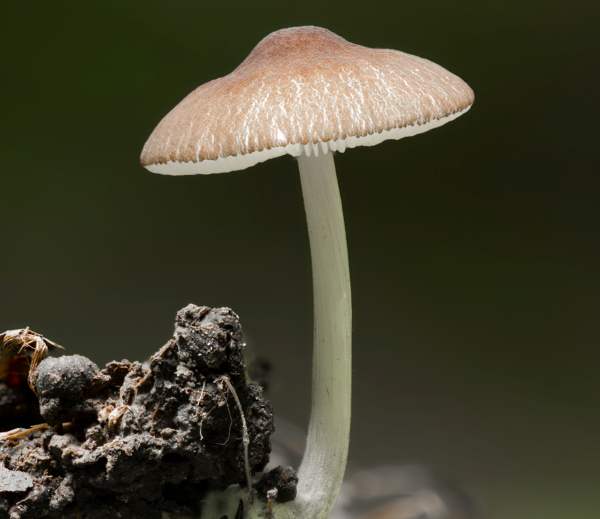
With very few exceptions, Pluteus mushrooms (commonly referred to as the 'shields'), require microscopic examination in order to achieve confident identification to species level. Pluteus podospileus is no exceptioon.
This rare woodland mushroom of summer and
autumn grows on the rotting wood of deciduous trees.
The radially lined cap and pale pink gills are characteristics shared by a number of other small shield mushrooms.
Distribution
Widespread but quite a rare find in Britain and Ireland, recorded mostly in the south, this wood-rotting mushroom is occasionally found in most other parts of mainland Europe from Scandinavia down to the Iberian Peninsula but most particularly where beech trees are plentiful. Pluteus podospileus is also recorded from North America and Australia.
Taxonomic history
The basionym of this species was established when it was described in 1887 by Italian mycologists Pier Andrea Saccardo and Guiseppe Cuboni (1852 - 1920); they gave it the binomial scientific name Pluteus podospileus by which it is generally known today.
Synonyms of Pluteus podospileus include Leptonia seticeps G.F. Atk., Pluteus minutissimus Maire, Pluteus seticeps (G.F. Atk.) Singer, and Pluteus podospileus f. minutissimus (Maire) Vellinga.
Etymology
Pluteus, the genus name, comes from Latin and literally means a protective fence or screen - a shield for example!
The specific epithet podospileus comes from the Greek podo- meaning foot, and -spilos (σπίλος) meaning a spot, fleck or blemish; hence podospileus implies 'with a spotted foot' (and for foot read stem when referring to mushrooms, of course. I am grateful to Jukka K. Korpela for kindly contributing this information.
Identification guide
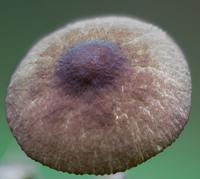 |
Cap
1.5 to 4cm in diameter, the cap is date brown to blackish brown, covered in minute pointed scales giving it felty appearance; convex at first and then flattened, sometimes slightly umbonate; translucently striate towards the margin. The cap flesh is whitish.
Stem
The stem is 2 to 4.5cm long and 1 to 3mm in
diameter broadening slightly towards the base. Its background colour is whitish; longitudinally striate; covered with tiny brownish flocculose scales often more densely in the lower part of the stem. The stem flesh is greyish brown. |
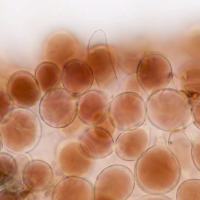 |
Pileipellis
The pileipellis is made up of pyriform elements (pear-shaped and therefore appearing round when viewed from directly above but inverted tear-drop shaped when seen in side view) interspersed with rather fewer elongate, fusiform-to-cylindrical elements.
|
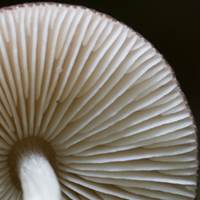 |
Gills
The broad, crowded free gills are white at first and turn pink and later brownish-pink as the spores mature. |
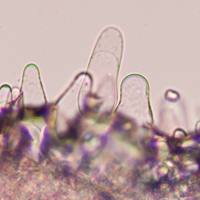 |
Cheilocystidia
These are the cystidia that occur on the gill edges. In Pluteus podospileus they are clavate to fusiform.
|
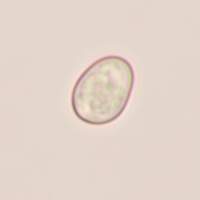 |
Spores
Subglobose to ovoid, smooth, 4-7 x 3.5-5µm.
|
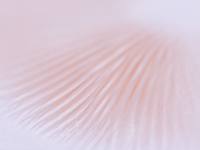 |
Spore print
Pale pink. |
Odour/taste |
Pleasant but not distinctive. |
Habitat & Ecological role |
Nearly always solitary but occasionally in small groups on stumps and rotting
fallen branches of broadleaf trees, particularly Beech and Ash, favouring damp sites and often in chalk-rich areas. |
Season |
Fruiting in Britain and Ireland during summer and autumn. |
Similar species |
Pluteus umbrosus is typically much larger; it has a radially-wrinkled
velvety cap rather than a flat velvety cap. |
Culinary Notes
Pluteus podospileus is not known to be edible and so should be avoided.
Reference Sources
Fascinated by Fungi, 2nd Edition, Pat O'Reilly 2016, reprinted by Coch-y-bonddu Books in 2022.
Orton, P.D. (1986). British Fungus Flora: Agarics and Boleti. Vol 4. Pluteaceae: Pluteus & Volvariella. Royal Botanic Garden: Edinburgh, Scotland.
Funga Nordica: 2nd edition 2012. Edited by Knudsen, H. & Vesterholt, J. ISBN 9788798396130
BMS List of English Names for Fungi
Dictionary of the Fungi; Paul M. Kirk, Paul F. Cannon, David W. Minter and J. A. Stalpers; CABI, 2008
Taxonomic history and synonym information on these pages is drawn from many sources but in particular from the British Mycological Society's GB Checklist of Fungi.
Acknowledgements
This page includes pictures kindly contributed by David Kelly.
Top of page...
Fascinated by Fungi. Back by popular demand, Pat O'Reilly's best-selling 450-page hardback book is available now. The latest second edition was republished with a sparkling new cover design in September 2022 by Coch-y-Bonddu Books. Full details and copies are available from the publisher's online bookshop...